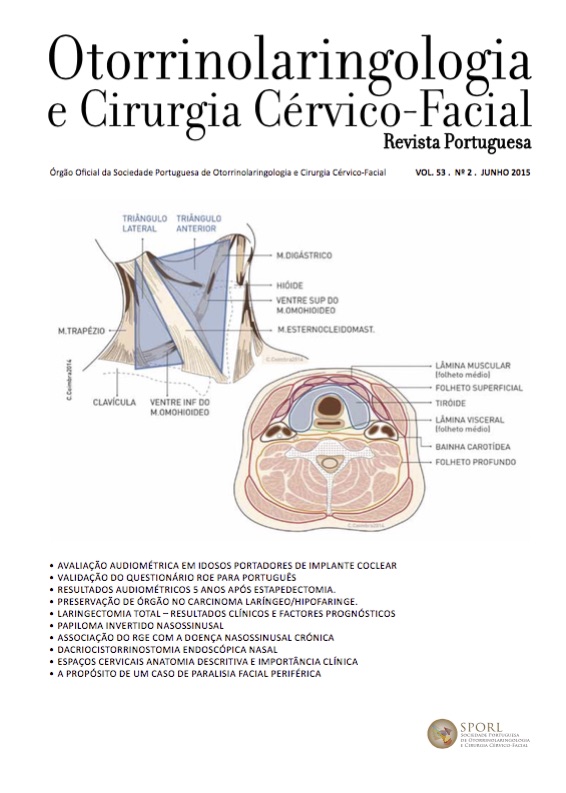Endoscopic nasal dacryocystorhinostomy: Results of Hospital Professor Doutor Fernando Fonseca
DOI:
https://doi.org/10.34631/sporl.586Keywords:
Dacryocystitis, Epyphora, Endoscopic dacryocystorhinostomy, resultsAbstract
Objective: analyze the results of a district hospital’s experience in endoscopic dacryocystorhinostomy and state the current role of this technique in the treatment of distal nasolacrimal pathway obstruction.
Methods: the clinical records of 67 consecutive endoscopic dacryocystorhinostomies performed in Hospital Professor Doutor Fernando Fonseca between January 1997 and December 2012 were reviewed. The clinical presentation, level of stenosis detected in the dacryocystography, intraoperative and postoperative complications and functional and anatomical results were analyzed.
Results: Of the 51 patients, 12 were male and 34 female, with an age-average of 57 years. Epyphora was the main symptom. With the exception of two cases, all surgeries were performed with powered tools. Endoscopic dacryocystorhinostomy success rate was 78,1%.
Conclusions: Endoscopic dacryocystorhinostomy is a simple, safe and effective technique for the treatment of distal obstructions of the nasolacrimal pathway.
Downloads
References
Christensen AL, Hansen PO, Jørgensen BG, Autzen T. Endoscopic dacryocystorhinostomy seems promising for lacrimal stenosis, Dan Med J 2013; 60(2): A4581.
Ruiz-Coello AM, Rodríguez BA, González CM, Salazar CLG, et al. Results of 12 years of endoscopic dacryocystorhinostomy. Acta Otorrinolaringol Esp 2011; 62 (1): 20−24.
Küpper DS, Demarco RC, Resende R, Anselmo-Lima WT, et al. Endoscopic nasal dacryocystorhinostomy: results and advantages over the external approach. Rev Bras Otorrinolaringol. 2005; 71: 356-60.
Leong SC, MacEwen CJ, White PS. A systematic review of outcomes after dacryocystorhinostomy in adults. Am J of Rhinol & Allergy, 2010; 24 (1): 82-90.
Piédrola MD, Sánchez JF, Reyes ER, Monje Vega E. Dacriocistorrinostomía endoscópica endonasal frente a transcanalicular con láser diodo. Técnicas quirúrgicas y resultados. Acta Otorrinolaringol Esp 2008; 59: 283-7.
Muscatello L, Giudice M, Spriano G, Tondini L. Endoscopic dacryocystorhinostomy: personal experience. Acta Otorhinolaryngol Ital. 2005; 25: 209-13.
McDonogh M, Meiring JH: Endoscopic transnasal dacryocystorhinostomy. J Laryngol Otol 1989; 103: 585-587.
Kingdom TT, Durairaj VD. Endoscopic dacryocystorhinostomy. Op Tech Otolaryngol 2006; 17: 43-48.
Sindwani R, Metson RB, Endoscopic dacryocystorhinostomy. Op Tech Otolaryngol 2008; 19: 172-176.
The British Association of Otorhinolaryngologists–Head and Neck Surgeons. Training standards for endonasal DCR (EN-DCR). ENTUK, The British Association of Otorhinolaryngologists–Head and Neck Surgeons, April 16, 2006. Disponível online em www.entuk.org/publications; acedido em 10 de Janeiro de 2013.
Mickelson SA, Kim DK, and Stein IM. Endoscopic laser-assisted dacryocystorhinostomy. Am J Otolaryngol 1997; 18: 107–111.
Hehar SS, Jones NS, Sadiq SA, et al. Endoscopic holmium:YAG laser dacryocystorhinostomy-safe and effective as a day-case procedure. J Laryngol Otol 1997. 111: 1056–1059.
Onerci M, Orhan M, Ogretmenog˘ lu O, et al. Long-term results and reasons for failure of intranasal endoscopic dacryocystorhinostomy. Acta Otolaryngol 2000; 120: 319–322.
Yigit O, Samancioglu M, Taskin U, et al. External and endoscopic dacryocystorhinostomy in chronic dacryocystitis: Comparison of results. Eur Arch Otorhinolaryngol 2007; 264: 879–885.
Wormald PJ, Tsirbas A. Powered endoscopic dacryocystorhinostomy with mucosal flaps. Op Technin Otolaryngol, 2009; 20: 92-95.
Ben Simon GJ, Joseph J, Lee S, et al. External versus endoscopic dacryocystorhinostomy for acquired nasolacrimal duct obstruction in a tertiary referral center. Ophthalmology 2005; 112: 1463–1468.
Muscatello L, Guidice M, Spriano G, et al. Endoscopic dacryocystorhinostomy: Personal experience. Acta Otorhinolaryngol Ital, 2005, 25: 209–213.
Ibrahim HA, Batterbury M, Banhegyi G, et al. Endonasal laser dacryocystorhinostomy and external dacryocystorhinostomy outcome profile in a general ophthalmic service unit: A comparative retrospective study. Ophthalmic Surg Lasers 2001; 32: 220–227.
Morgan S, Austin M, and Whittet H. The treatment of acute dacryocystitis using laser assisted endonasal dacryocystorhinostomy. Br J Ophthalmol 2004, 88: 139–141.
Umapathy N, Kalra S, Skinner DW, et al. Long-term results of endonasal laser dacryocystorhinostomy. Otolaryngol Head Neck Surg 2006, 135:81–84.
Unlu HH, Toprak B, Aslan A, et al. Comparison of surgical outcomes in primary endoscopic dacryocystorhinostomy with and without silicone intubation. Ann Otol Rhinol Laryngol 2002, 111: 704–709.
Zaman M, Babar TF, and Abdullah A. Prospective randomized comparison of dacryocystorhinostomy (DCR) with and without intubation. Pak J Med Res 2005, 44: 75–78.
Deka A, Bhattacharjee K, Bhuyan SK, et al: Effect of mitomycin C on ostium in dacryocystorhinostomy. Clin Exp Ophthalmol 2006; 34:557-561.
Camara JG, Bengzon AU, Henson RD: The safety and efficacy of mitomycin C in endonasal endoscopic laser-assisted dacryocystorhinostomy. Ophthal Plast Reconstr Surg 2000, 16: 114.






